 Now this is going to be a bit of a heady read this as it’s a cross between a trip back in time and a Time Line. What are we talking about you ask? The ongoing saga of lost photos and stories continues and now we have turned up some piccies of what was the very first purpose built cruise liner and our part in her career. Back in the day my Uncle John was an airline pilot for BOAC. He arrived in this position having served in the Pacific during WW2 and then moved onto ferrying aircraft down to Africa and eventually flying for South African Airways who became part of BOAC. He had a very nice house high above Sidmouth in Devon and we’d often go and visit during the summer holidays. As we were car-less we’d catch the Atlantic Coast Express out of Waterloo, usually pulled by a mighty Oliver Bullied designed Merchant Navy Class locomotive all named after Shipping Lines, I’ve got Netherland Line, Ellerman Line, Holland America Line, Clan Line and Elders Fyffes listed in my Ian Allan spotters book (amongst others). With the best looking cast driving wheels ever fitted to a steam engine these were magnificent. The set (carriages) was made up in order of dropping the coaches at the various Junctions on the way so we’d be sat near the back in the ‘Waterloo’ bit and our coach would be slipped at Sidmouth Junction and coupled up to the local service, seamless travel, but it was a bit of a bummer if you spent too much time in the restaurant car and sailed through your Junction!
Now this is going to be a bit of a heady read this as it’s a cross between a trip back in time and a Time Line. What are we talking about you ask? The ongoing saga of lost photos and stories continues and now we have turned up some piccies of what was the very first purpose built cruise liner and our part in her career. Back in the day my Uncle John was an airline pilot for BOAC. He arrived in this position having served in the Pacific during WW2 and then moved onto ferrying aircraft down to Africa and eventually flying for South African Airways who became part of BOAC. He had a very nice house high above Sidmouth in Devon and we’d often go and visit during the summer holidays. As we were car-less we’d catch the Atlantic Coast Express out of Waterloo, usually pulled by a mighty Oliver Bullied designed Merchant Navy Class locomotive all named after Shipping Lines, I’ve got Netherland Line, Ellerman Line, Holland America Line, Clan Line and Elders Fyffes listed in my Ian Allan spotters book (amongst others). With the best looking cast driving wheels ever fitted to a steam engine these were magnificent. The set (carriages) was made up in order of dropping the coaches at the various Junctions on the way so we’d be sat near the back in the ‘Waterloo’ bit and our coach would be slipped at Sidmouth Junction and coupled up to the local service, seamless travel, but it was a bit of a bummer if you spent too much time in the restaurant car and sailed through your Junction! 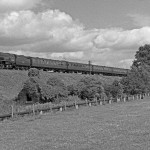 The picture (click on it to see it properly, its brilliant) is Netherlands Line taken in 1962 and we were probably in one of the last three coaches. One of the highlights, and the first thing we usually did when alighting at Sidmouth station, was to get a local paper to find out the times of the passing liners as they sailed out into the Atlantic or were returning to Southampton. On this particular occasion Caronia and Queen Elizabeth were due and a plan was hatched to catch the train, probably another Bullied hauled number, to Southampton and see them in port. Somehow the old man reckoned that we could go by train right into the Ocean Terminal. Which is what we did, quite how I cannot remember but it was pretty special. That’s the connection out of the way but what needs to be borne in mind is when all this happened and the date we, my brother and I, got taken to Southampton to see RMS Queen Elizabeth and the Caronia. We reckon it was back in 1963 and little did we realise it then but the sun had almost set on the scheduled Trans-Atlantic crossing and both ships would be retired within a few years and both lost at sea in unfortunate circumstances.
The picture (click on it to see it properly, its brilliant) is Netherlands Line taken in 1962 and we were probably in one of the last three coaches. One of the highlights, and the first thing we usually did when alighting at Sidmouth station, was to get a local paper to find out the times of the passing liners as they sailed out into the Atlantic or were returning to Southampton. On this particular occasion Caronia and Queen Elizabeth were due and a plan was hatched to catch the train, probably another Bullied hauled number, to Southampton and see them in port. Somehow the old man reckoned that we could go by train right into the Ocean Terminal. Which is what we did, quite how I cannot remember but it was pretty special. That’s the connection out of the way but what needs to be borne in mind is when all this happened and the date we, my brother and I, got taken to Southampton to see RMS Queen Elizabeth and the Caronia. We reckon it was back in 1963 and little did we realise it then but the sun had almost set on the scheduled Trans-Atlantic crossing and both ships would be retired within a few years and both lost at sea in unfortunate circumstances.
 Although the age of jet travel had, pardon the pun, taken off with the arrival of the Comet and later the Boeing 707, back in 1963 Turbo prop Britannias were still operating the North Atlantic routes, joined by the popular VC10 the following year. It wouldn’t be until 1971 that the first BOAC Jumbo jets entered service and mass air transportion really began. The fares were high even for the equivilant of steerage and the age of cheap flights didn’t happen until Mr Laker
Although the age of jet travel had, pardon the pun, taken off with the arrival of the Comet and later the Boeing 707, back in 1963 Turbo prop Britannias were still operating the North Atlantic routes, joined by the popular VC10 the following year. It wouldn’t be until 1971 that the first BOAC Jumbo jets entered service and mass air transportion really began. The fares were high even for the equivilant of steerage and the age of cheap flights didn’t happen until Mr Laker 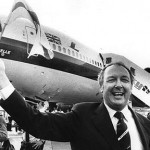 came along and made flying the Atlantic accessible and affordable. Strange as it may seem now but it was only back in 1977 that he founded the idea of the ‘no frills airline’ that we all enjoy today. It is fair to say his business plan got rather overstretched but he was, in the end, forced out of business by the big players who could afford to lose a few quid here and there. When Virgin came along, using lessons learnt from Sir Freddie and capitalising on the use of the interweb, the game plan was changed forever and now you can surf the net and get some quite extraordinary deals on Trans-Atlantic flights most days of the week. So, taking a step back, what was the crack in 1963 when my brother and I leant against the viewing balcony on the Ocean Terminal in Southampton? By 1959 the numbers crossing the Atlantic by air had almost matched those sailing and by 1964 the age of the scheduled Trans-Atlantic liner service pretty much came to an end. The last ships to be built as ocean liners were launched in the early sixties but their careers in that role were short and they were soon being used for cruises rather than scheduled services.
came along and made flying the Atlantic accessible and affordable. Strange as it may seem now but it was only back in 1977 that he founded the idea of the ‘no frills airline’ that we all enjoy today. It is fair to say his business plan got rather overstretched but he was, in the end, forced out of business by the big players who could afford to lose a few quid here and there. When Virgin came along, using lessons learnt from Sir Freddie and capitalising on the use of the interweb, the game plan was changed forever and now you can surf the net and get some quite extraordinary deals on Trans-Atlantic flights most days of the week. So, taking a step back, what was the crack in 1963 when my brother and I leant against the viewing balcony on the Ocean Terminal in Southampton? By 1959 the numbers crossing the Atlantic by air had almost matched those sailing and by 1964 the age of the scheduled Trans-Atlantic liner service pretty much came to an end. The last ships to be built as ocean liners were launched in the early sixties but their careers in that role were short and they were soon being used for cruises rather than scheduled services. 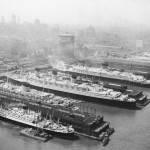 By 1969 the big liners like the Queen Elizabeth and Queen Mary and SS United States had been retired and today the only scheduled service between Southampton and New York is by Queen Mary 2 between April and October and these days they are known as ‘cruises’ and there are only a few of them. If you have a fear of flying and have to travel by ship the best way to do it today is aboard a freighter or on a re-positioning voyage. Ah! The romance of the sea!
By 1969 the big liners like the Queen Elizabeth and Queen Mary and SS United States had been retired and today the only scheduled service between Southampton and New York is by Queen Mary 2 between April and October and these days they are known as ‘cruises’ and there are only a few of them. If you have a fear of flying and have to travel by ship the best way to do it today is aboard a freighter or on a re-positioning voyage. Ah! The romance of the sea!
 The Ocean Terminal we went to was a splendid building completed in 1950 and benefited from a public gallery so that you could wave bye-bye as the ship shoved off and that and was where we headed. There was a purpose-built rail link that brought the special Boat Trains which ran from Waterloo right alongside. The decision to go down to the Docks came about mainly because the old man had never seen the RMS Caronia, famous for being painted a very pleasing pale green and known affectionately as ‘The Green Goddess’, no relation to the fire engines may I add, and was due into Southampton around noon but there had been some question as to what time it would be passing Sidmouth or indeed if it would come in close enough to see, so it was sandwiches and an early start. The Queen Elizabeth was being restocked and was due to sail in a few days time so we would see her later in the week. There was plenty of to-ing and fro-ing and loading of cases and stores but not a soul on the decks, which seemed a bit odd, however we duly stood on the viewing platform by the bows and had our pictures taken. I’ve had a good look at the pictures and cannot for the life of me figure out where the Queen Elizabeth was moored or where the Caronia docked and had always assumed it was opposite the Terminal but I seem to think we watched the Caronia come in from there so it’s a bit of a puzzle. In fairness it was a few years ago now.
The Ocean Terminal we went to was a splendid building completed in 1950 and benefited from a public gallery so that you could wave bye-bye as the ship shoved off and that and was where we headed. There was a purpose-built rail link that brought the special Boat Trains which ran from Waterloo right alongside. The decision to go down to the Docks came about mainly because the old man had never seen the RMS Caronia, famous for being painted a very pleasing pale green and known affectionately as ‘The Green Goddess’, no relation to the fire engines may I add, and was due into Southampton around noon but there had been some question as to what time it would be passing Sidmouth or indeed if it would come in close enough to see, so it was sandwiches and an early start. The Queen Elizabeth was being restocked and was due to sail in a few days time so we would see her later in the week. There was plenty of to-ing and fro-ing and loading of cases and stores but not a soul on the decks, which seemed a bit odd, however we duly stood on the viewing platform by the bows and had our pictures taken. I’ve had a good look at the pictures and cannot for the life of me figure out where the Queen Elizabeth was moored or where the Caronia docked and had always assumed it was opposite the Terminal but I seem to think we watched the Caronia come in from there so it’s a bit of a puzzle. In fairness it was a few years ago now.
 The Caronia came up the Test under tow chaperoned by busy, fussy tugs in the afternoon and what a sight she was. She looked stunning in a truly lovely shade of green and with a huge single funnel she was every inch an oversized gentlemans’ yacht. It was, however, claimed that the huge funnel could be a bit of a problem in strong crosswinds! When you look at the sweeping lines and raked bow it makes the modern cruise liners look like cargo vessels the stacked containers simply having windows punched in them. Some say the new ships are simply huge floating blocks of flats but that is being a tad rude about blocks of flats. I have to say I could well understand, even at that age, why my dad had wanted to see her. Truth be told she is probably the most under-rated ship ever built and as far as the very rich and famous were concerned the most popular. It is reported a few very wealthy souls actually lived aboard all year round at some cost so friendly and accommodating were her crew. When cruising the they would put up a sign above the gangplank simply saying ‘Welcome Home’, now that’s thoughtfulness for you. We watched awestruck as a tug gently nudged her alongside, most professional my brother and I thought.
The Caronia came up the Test under tow chaperoned by busy, fussy tugs in the afternoon and what a sight she was. She looked stunning in a truly lovely shade of green and with a huge single funnel she was every inch an oversized gentlemans’ yacht. It was, however, claimed that the huge funnel could be a bit of a problem in strong crosswinds! When you look at the sweeping lines and raked bow it makes the modern cruise liners look like cargo vessels the stacked containers simply having windows punched in them. Some say the new ships are simply huge floating blocks of flats but that is being a tad rude about blocks of flats. I have to say I could well understand, even at that age, why my dad had wanted to see her. Truth be told she is probably the most under-rated ship ever built and as far as the very rich and famous were concerned the most popular. It is reported a few very wealthy souls actually lived aboard all year round at some cost so friendly and accommodating were her crew. When cruising the they would put up a sign above the gangplank simply saying ‘Welcome Home’, now that’s thoughtfulness for you. We watched awestruck as a tug gently nudged her alongside, most professional my brother and I thought.
 The Caronia was built for Cunard White Star at John Brown’s Shipyard on Clydebank in Glasgow and launched in 1947 and her maiden voyage to New York departed from Southampton in January 1949. At 34,183 tons she was the first ship to be purpose built as both a Trans-Atlantic liner and a cruise ship with mixed first and second class cabins that could be converted to all first for the top of the range cruises. With an almost one to one passenger crew ratio she offered the highest standards of any ship in service. She had bathroom and shower facilities in every cabin (including fresh water), air conditioning throughout and the first outdoor swimming pool. During the time she was operated by Cunard she developed an enviable reputation for quality and luxury travel and only in her final years did she fail to return a profit. It wasn’t for nothing that she became known world-wide as ‘The Millionaires Yacht’. In the first couple of years she operated mainly on the Atlantic Service but back in 1951 she completed a World Cruise lasting 111 days, covering 32,000 miles and visiting 35 ports which cost between $3400 to $30,000 depending on your cabin. Perhaps her most notable cruise was the 37 day Coronation Cruise of 1953. It was marketed as “a truly once-in-a-lifetime European holiday, arriving in England just in time for the pageantry of Coronation and the celebration of the Queen’s birthday, including preferred seats for the Coronation Procession” and to ensure only the well rich would be aboard suites for this special voyage were a very handsome $12,000 (all fares on her were quoted in dollars). By 1960s things were changing and despite a refit in 1965, with dwindling passenger numbers and the arrival of the more modern and cost-effective cruise ships, not helped by a depression along with dock and seaman strikes,
The Caronia was built for Cunard White Star at John Brown’s Shipyard on Clydebank in Glasgow and launched in 1947 and her maiden voyage to New York departed from Southampton in January 1949. At 34,183 tons she was the first ship to be purpose built as both a Trans-Atlantic liner and a cruise ship with mixed first and second class cabins that could be converted to all first for the top of the range cruises. With an almost one to one passenger crew ratio she offered the highest standards of any ship in service. She had bathroom and shower facilities in every cabin (including fresh water), air conditioning throughout and the first outdoor swimming pool. During the time she was operated by Cunard she developed an enviable reputation for quality and luxury travel and only in her final years did she fail to return a profit. It wasn’t for nothing that she became known world-wide as ‘The Millionaires Yacht’. In the first couple of years she operated mainly on the Atlantic Service but back in 1951 she completed a World Cruise lasting 111 days, covering 32,000 miles and visiting 35 ports which cost between $3400 to $30,000 depending on your cabin. Perhaps her most notable cruise was the 37 day Coronation Cruise of 1953. It was marketed as “a truly once-in-a-lifetime European holiday, arriving in England just in time for the pageantry of Coronation and the celebration of the Queen’s birthday, including preferred seats for the Coronation Procession” and to ensure only the well rich would be aboard suites for this special voyage were a very handsome $12,000 (all fares on her were quoted in dollars). By 1960s things were changing and despite a refit in 1965, with dwindling passenger numbers and the arrival of the more modern and cost-effective cruise ships, not helped by a depression along with dock and seaman strikes,  Cunard withdrew her and the Queen Mary from service in 1967. Her last voyage under the Cunard flag was, most appropriately, from New York to Southampton on 24th November 1967 docking at Berth 101 where the crew of 600 stood down. Now looking through the amazing website set up by Peter Stevens we reckon the pictures were taken of her arrival on August 6th 1963 following one of her very popular North Cape cruises.
Cunard withdrew her and the Queen Mary from service in 1967. Her last voyage under the Cunard flag was, most appropriately, from New York to Southampton on 24th November 1967 docking at Berth 101 where the crew of 600 stood down. Now looking through the amazing website set up by Peter Stevens we reckon the pictures were taken of her arrival on August 6th 1963 following one of her very popular North Cape cruises.
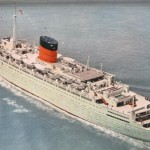 Following her retirement, after her return to Southampton, following a number of potential sales, including one to the Swedish Government to be used as a temporary office whilst the new Parliament building was being constructed she was eventually sold, complete with all her fittings, to Star Shipping in 1968, renamed SS Columbia and went to Greece for a somewhat dubious refit during which Andrew Konstaninidis took control of Star Line and renamed her SS Caribia, re-painted her white and formed Universal Cruise Lines to to operate her as a Caribbean cruise ship sailing under the Panamanian flag. On 14th February 1969 the Caribia’s maiden cruise departed six days late and on her return on the morning of the 28th February, 400 of the 500 passengers petitioned the company complaining about ‘inadequate service, inadequate food, improperly functioning equipment and generally unsatisfactory conditions’. Unbelievably that afternoon 325 passengers embarked for her next cruise. Tragically five days into the cruise an explosion in the generator room killed one crew member and seriously scalded another. The accident resulted in the total loss of electrical power to the ship. After drifting for some 20 hours temporary repairs were successfully completed and steam was finally raised allowing her to head slowly back to New York.
Following her retirement, after her return to Southampton, following a number of potential sales, including one to the Swedish Government to be used as a temporary office whilst the new Parliament building was being constructed she was eventually sold, complete with all her fittings, to Star Shipping in 1968, renamed SS Columbia and went to Greece for a somewhat dubious refit during which Andrew Konstaninidis took control of Star Line and renamed her SS Caribia, re-painted her white and formed Universal Cruise Lines to to operate her as a Caribbean cruise ship sailing under the Panamanian flag. On 14th February 1969 the Caribia’s maiden cruise departed six days late and on her return on the morning of the 28th February, 400 of the 500 passengers petitioned the company complaining about ‘inadequate service, inadequate food, improperly functioning equipment and generally unsatisfactory conditions’. Unbelievably that afternoon 325 passengers embarked for her next cruise. Tragically five days into the cruise an explosion in the generator room killed one crew member and seriously scalded another. The accident resulted in the total loss of electrical power to the ship. After drifting for some 20 hours temporary repairs were successfully completed and steam was finally raised allowing her to head slowly back to New York.
Back in New York all further cruises were cancelled and legal battles raged in the form of lawsuits and claims against the cruise promoters and operators. Konstaninidis stated that he would restore the ship to operate a regular New York to the Bahamas service but there was no money available to repair her, a figure that quickly rose to an estimated $2m. Eventually, still moored in New York and now sporting a parking ticket, she was reluctantly sold to a Taiwanese ship breakers for scrap and on 27th April 1974 she departed from the Bush Terminal in Brooklyn, towed out by the German ocean-going tug ‘Hamburg’ behind a 1,500 yard five and a half inch steel cable. The cable itself connected to the tug by a short heavy nylon hawser allowing it to be cut free if needed, something that eventually proved a blessing. The planned 100 day voyage went well and after passing through the Panama Canal Captain Spannhake, a very experienced tug captain, headed for Hawaii and a planned refuelling stop. En-route one of the Hamburg’s engines broke down but eventually they made it into Honolulu and repairs were made. Setting sail from Hawaii they ran into further trouble when one of the turbo-chargers on the starboard engine packed up considerably reducing power. As if this wasn’t enough, now running well behind schedule, they ran headlong into Typhoon Mary as they approached Guam. Captain Spannhake called Apra Harbour requesting assistance but the strong winds that were now gusting to 45 knots and a very heavy swell meant that the Navy and Coast Guard tugs were unable to leave the harbour in time. By now they were in a position to attempt a dash for the entrance but the strong winds and current were pushing both vessels towards the Glass breakwater, 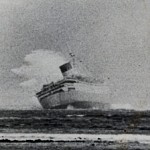 The Hamburg swung astern and attempted to prevent the Caribia from going aground but the reduced power from the engines and the sea, now running with 40 foot waves, defeated her and 800 yards out from the breakwater the towline was cut. The Hamburg immediately swung out to avoid going aground on Orote Point opposite leaving the once majestic Caronia on her own and she ran into the breakwater just before nine o’clock in the morning. The Coastguard managed to get the three crewmen off and by early afternoon the continual battering by the strong sea took its toll on her hull and she broke apart leaving only the bow section on the rocks the rest sliding into the harbour entrance.
The Hamburg swung astern and attempted to prevent the Caribia from going aground but the reduced power from the engines and the sea, now running with 40 foot waves, defeated her and 800 yards out from the breakwater the towline was cut. The Hamburg immediately swung out to avoid going aground on Orote Point opposite leaving the once majestic Caronia on her own and she ran into the breakwater just before nine o’clock in the morning. The Coastguard managed to get the three crewmen off and by early afternoon the continual battering by the strong sea took its toll on her hull and she broke apart leaving only the bow section on the rocks the rest sliding into the harbour entrance. 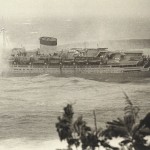 It was four days before scanning equipment could be used to find out exactly where the rest of the ship lay and the harbour entrance could be safely re-opened. Hamburg’s owner’s were ordered to post a bond of $3m dollars pending a $4m dollar claim by the US Government for salvage and damages. The legacy of the Caribia wasn’t quite over yet. During the salvage work Navy divers came across an old landing craft right next to the wreck still containing 50 tons of explosives. It took the Explosive Ordinance Division 952 dives totalling 388 hours to clear it before work could continue. Despite warnings and ‘prohibited’ signs going up local divers helped themselves to just about anything that could be unscrewed especially the portholes which now apparently grace many a home on the island! Finally in 1975 the Nippon Salvage Company from Japan were contracted to clear her for scrap achieved by cutting the entire ship into 400 ton sections, a job that was completed in 1977.
It was four days before scanning equipment could be used to find out exactly where the rest of the ship lay and the harbour entrance could be safely re-opened. Hamburg’s owner’s were ordered to post a bond of $3m dollars pending a $4m dollar claim by the US Government for salvage and damages. The legacy of the Caribia wasn’t quite over yet. During the salvage work Navy divers came across an old landing craft right next to the wreck still containing 50 tons of explosives. It took the Explosive Ordinance Division 952 dives totalling 388 hours to clear it before work could continue. Despite warnings and ‘prohibited’ signs going up local divers helped themselves to just about anything that could be unscrewed especially the portholes which now apparently grace many a home on the island! Finally in 1975 the Nippon Salvage Company from Japan were contracted to clear her for scrap achieved by cutting the entire ship into 400 ton sections, a job that was completed in 1977.  The project was managed by the US Army Corps’ of Engineers, Pacific Ocean Division (POD) and as a memento of the largest salvage operation ever undertaken by the Corps, the Caribia’s compass was presented to them and is now in the Corps’ Museum collection housed in the Office of History. In some ways it was a good way for her to go and one of these days we’ll stop off in Guam and go and have a look through one of her portholes.
The project was managed by the US Army Corps’ of Engineers, Pacific Ocean Division (POD) and as a memento of the largest salvage operation ever undertaken by the Corps, the Caribia’s compass was presented to them and is now in the Corps’ Museum collection housed in the Office of History. In some ways it was a good way for her to go and one of these days we’ll stop off in Guam and go and have a look through one of her portholes.
 The Queen Elizabeth made her last crossing of the Atlantic in 1968 having carried 2,300,000 passengers and sailed a total of 3,472,675 miles. She was originally sold to a group of Philidelphia businessmen with the intention of setting her up in the Everglades as a hotel and tourist attraction but after losing money and being declared a fire hazard she was sold by auction to Hong Kong tycoon C. Y. Tung who planned to use her as a combined cruise ship and floating University. Her engines and six of her 12 boilers were made operational and she attempted to sail to Hong Kong Harbour but ended up having to summon help when she got down to only three working boilers and a fire broke out in number 4 Boiler Room. She was towed to the island of Aruba off the Venezualan coast where more boiler tubes were fitted and she finally got away finally making Hong Kong Harbour where she underwent a £5m major refit which included refurbishing all the boilers and overhauling the engines and meeting all the latest fire regulations. All that was left to do was to dry-dock her and she would be ready for service. It seemed there would be a happy ending after all but on the 9th January 1972, just before the work was completed, she mysteriously caught fire, burnt out and finally capsized, mainly the result of the thousands of gallons of water pumped into her in the attempt to put the fires out.
The Queen Elizabeth made her last crossing of the Atlantic in 1968 having carried 2,300,000 passengers and sailed a total of 3,472,675 miles. She was originally sold to a group of Philidelphia businessmen with the intention of setting her up in the Everglades as a hotel and tourist attraction but after losing money and being declared a fire hazard she was sold by auction to Hong Kong tycoon C. Y. Tung who planned to use her as a combined cruise ship and floating University. Her engines and six of her 12 boilers were made operational and she attempted to sail to Hong Kong Harbour but ended up having to summon help when she got down to only three working boilers and a fire broke out in number 4 Boiler Room. She was towed to the island of Aruba off the Venezualan coast where more boiler tubes were fitted and she finally got away finally making Hong Kong Harbour where she underwent a £5m major refit which included refurbishing all the boilers and overhauling the engines and meeting all the latest fire regulations. All that was left to do was to dry-dock her and she would be ready for service. It seemed there would be a happy ending after all but on the 9th January 1972, just before the work was completed, she mysteriously caught fire, burnt out and finally capsized, mainly the result of the thousands of gallons of water pumped into her in the attempt to put the fires out. 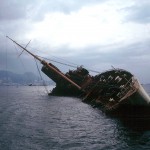 Various theories have been put forward to explain the incident including an insurance scam and a dispute between Tung, who was a Chinese Nationalist, and the Communist-dominated ship construction unions but whatever happened she was broken up where she lay and the remains blown up. Contrary to myth and legend a fair amount of her remains still lay under the mud in Hong Kong Harbour just off Container Terminal 9. The Southampton Ocean Terminal we visited was demolished in 1983 but, like the Caronia and Queen Elizabeth, not without a struggle. It turns out that the contractor employed to demolish the behemoth managed to destroy his crane when the wrecking ball bounced off the concrete wall and smashed into it effectively putting him out of business. Three out of three then
Various theories have been put forward to explain the incident including an insurance scam and a dispute between Tung, who was a Chinese Nationalist, and the Communist-dominated ship construction unions but whatever happened she was broken up where she lay and the remains blown up. Contrary to myth and legend a fair amount of her remains still lay under the mud in Hong Kong Harbour just off Container Terminal 9. The Southampton Ocean Terminal we visited was demolished in 1983 but, like the Caronia and Queen Elizabeth, not without a struggle. It turns out that the contractor employed to demolish the behemoth managed to destroy his crane when the wrecking ball bounced off the concrete wall and smashed into it effectively putting him out of business. Three out of three then
Just in case you don’t think we can link this up to balloons, some years back I flew the Unipart Oil Can from the Southampton Balloon Festival that used to be held on Southampton Common. It was a morning flight and I flew solo for some reason. The lower winds were generally northerly light and variable with the upper wind having a fair smattering of east in it. Keeping low it was apparent that I could get over the docks, maybe land there and if not then, with a bit of luck, climbing would take me across the Test and up towards Totten and Ashurst on the edge of the New Forest. I had always wanted to see them from the air and this could be the day. All went better than expected and I dropped down literally just to the east of the Royal Pier, I would have liked to have sailed down the Ocean Dock but it wasn’t to be. Still heading south, now very low down, as I came out into the Test the mighty Oilcan turned left and started heading for Southampton Water. This was just brilliant but I had to keep just above the water, more than ten foot up and I was back crossing the river. I was so busy keeping the thing low and being famous waving to some fishermen on the Town Pier that I sort of forgot where I was. Suddenly it seemed I was looking down the Ocean Dock. This was quite the most amazing thing and there wasn’t a soul about. It was huge and somehow, in my mind, a bit dark and foreboding but the water had the faintest of ripples across it and almost sparkled. I did some serious smiling. Unfortunately there weren’t any ships in but to be honest I could see the Queen Elizabeth’s stern, a sliver of smoke rising from a funnel. All was good. Whilst I was busy looking up at the enormous quays and down the Dock realisation dawned that I was going completely the wrong way but looking back up the Test I could see balloons apparently over Totton so I reasoned all should be good. Now I was gently paralleling the South Dock and closing on the  mouth of the Itchen, time to go up. Now I was looking down on the Docks complex and heading away from my possible trip down Southampton Water. There is no way I would ever have seen the Ocean Dock from that perspective unless it was in a canoe, I was elated and just hoped trusty Greg and Paul would be understanding. I eventually ended up somewhere south of Marchwood on a very nice farmer who gave us some goose eggs. Now if I’d had a camera!!!!
mouth of the Itchen, time to go up. Now I was looking down on the Docks complex and heading away from my possible trip down Southampton Water. There is no way I would ever have seen the Ocean Dock from that perspective unless it was in a canoe, I was elated and just hoped trusty Greg and Paul would be understanding. I eventually ended up somewhere south of Marchwood on a very nice farmer who gave us some goose eggs. Now if I’d had a camera!!!!
http://www.caronia2.info/home.php Run by Peter Stevens this is the most comprehensive and brilliant site (about any ship) dedicated to the RMS Caronia with everything you ever wanted to know including passenger and crew lists, cruise details and personal memories of the Caronia.
http://www.bytenet.net/rmscaronia/ Brian Hawley’s interesting site on Trans-Atlantic liners. Thanks for the pics.
http://www.usace.army.mil/About/History/HistoricalVignettes/CivilEngineering/093ShipSalvage.aspx A bit about the POD’s involvement.
http://www.liverpoolships.org/cunard_white__star_queen_elizabeth_1938.html nice potted history of the Queen Elizabeth.
http://www.flickr.com/photos/31514768@N05/3525879703/in/set-72157615594816930 One of the loveliest photographs ever of a steam engine in full flight, this time Netherland Line and here are some more great ACE pictures courtesy of Charlie Verrall.
http://www.bytenet.net/rmscaronia/Main%20Caronia%20page.html